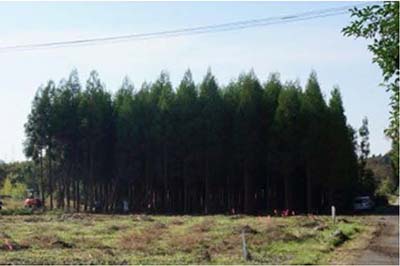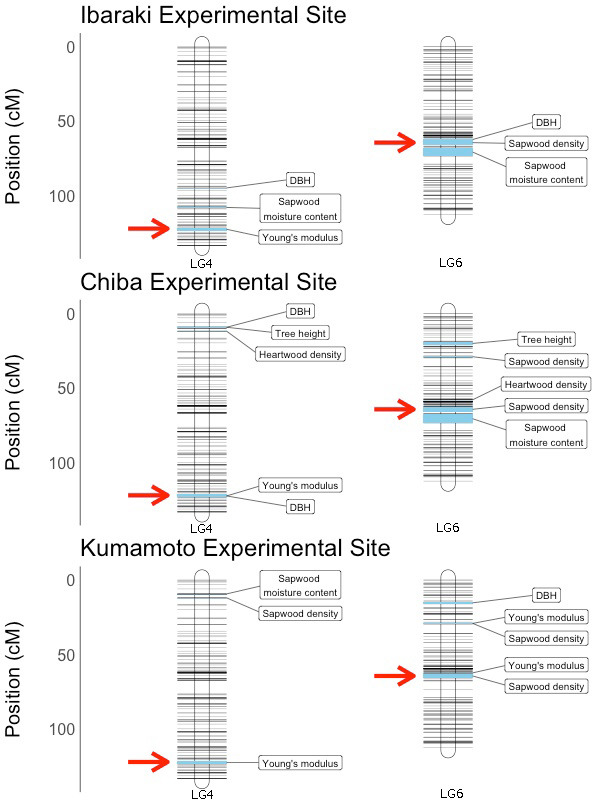Home > Research > Research Results > Research Results 2019 > Genetic mapping of growth and wood properties in Cryptomeria japonica reveals the effects of the growth environments
Update:November 5, 2019
Main content starts here.
Genetic mapping of growth and wood properties in Cryptomeria japonica reveals the effects of the growth environments
| Article title |
Mapping quantitative trait loci for growth and wood property traits in Cryptomeria japonica across multiple environments |
|---|---|
| Author (affiliation) |
Hideki Mori (a), Saneyoshi Ueno (a), Tokuko Ujino-Ihara (a), Takeshi Fujiwara (b), Kana Yamashita (c), Seiichi Kanetani (d), Ryota Endo (e), Asako Matsumoto (a), Kentaro Uchiyama (a), Yukari Matsui (f), Takahiro Yoshida (c), Yoshimi Sakai (d), Yoshinari Moriguchi (g), Ryouichi Kusano (f), Yoshihiko Tsumura (h) (a) Department of Forest Molecular Genetics and Biotechnology, FFPRI, Tsukuba, Ibaraki, Japan. (b) Forest Bio-Research Center, FFPRI, Hitachi, Ibaraki, Japan. (c) Department of Wood Properties and Processing, FFPRI, Tsukuba, Ibaraki, Japan. (d) Kyushu Research Center, FFPRI, Kumamoto, Kumamoto, Japan. (e) Forestry Research Institute, Chiba Prefectural Agriculture and Forestry Research Center, Sammu, Chiba, Japan. (f) Kumamoto Prefecture Forestry Research Center, Kumamoto, Japan. (g) Niigata University, Nishi-ku, Niigata, Japan. (h) University of Tsukuba, Tsukuba, Ibaraki, Japan. |
| Publication Journal |
Tree Genetics & Genomes, 43:1-15, Springer, June 2019 DOI:10.1007/s11295-019-1346-5( External link ) |
| Content introduction |
The growth and properties of wood are influenced both by genetics and the environment. Growth environments are likely to dramatically change in the future because of climate change. To address this issue, identification of the genomic regions associated with wood growth and properties in Cryptomeria japonica, a tree species that is important to forestry in Japan and analysis of the effects of the growth environment on these properties was performed. For this study, seedlings of 139 different C. japonica clones, which were acquired by crossbreeding the plants growing in the Kyushu region, were planted at experimental sites situated in the Ibaraki, Chiba, and Kumamoto Prefectures (Figure 1). Approximately 10 years after planting the seedlings, the amount of growth and properties of the wood were determined and the correlation between their genetic information and these traits was analyzed. The results of the study showed that on average there were 53 genomic regions in the three experimental sites. Certain genomic regions of interest were identified as being common to trees at all the experimental sites (Figure 2); however, most varied between experimental sites. This finding reveals that the traits of C. japonica wood may be influenced not only by the genetic information but also by the growth environment. This result provides important information that will assist with forestry planning to prepare for future challenges associated with climate change.
Figure 1. Experimental planting site in Kumamoto Prefecture
Figure 2. Genetic map illustrating the genomic regions associated with specific traits of Cryptomeria japonica Arrows indicate the genomic regions in which the effects on the traits were observed commonly at the three experimental sites. The genomic regions commonly identified at all experimental sites were limited to linkage groups 4 (LG4) and 6 (LG6). |
Copyright © Forest Research and Management Organization. All rights reserved.


